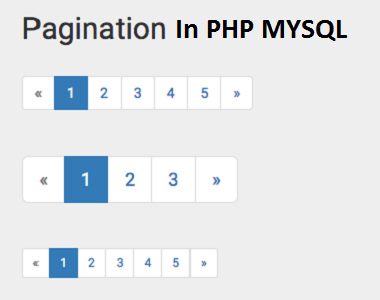Hi Geeks,
We have gone through some user requests for pagination code for php mysql project.So we have created a simple class where you can easily create pagination for any grid or listing. following are the simple steps for making a pagination system in php.
Step 1: Create a class file ‘Paginator.class.php’ in your project with following code snippet
<?php
class Paginator {
private $_conn;
private $_limit;
private $_page;
private $_query;
private $_total;
public function __construct( $conn, $query ) {
$this->_conn = $conn;
$this->_query = $query;
$rs= $this->_conn->query( $this->_query );
$this->_total = $rs->num_rows;
}
public function getData( $limit = 10, $page = 1 ) {
$this->_limit = $limit;
$this->_page = $page;
if ( $this->_limit == 'all' ) {
$query = $this->_query;
} else {
$offset=( ( $this->_page - 1 ) * $this->_limit );
$query = $this->_query . " LIMIT " . $offset . ", $this->_limit";
}
$rs = $this->_conn->query( $query );
$results=array();
while ( $row = $rs->fetch_assoc() ) {
$results[] = $row;
}
$result = new stdClass();
$result->page = $this->_page;
$result->limit = $this->_limit;
$result->total = $this->_total;
$result->data = $results;
return $result;
}
public function append_existing_query_string($qstring)
{
if(isset($_GET))
{
foreach($_GET as $k=>$v)
{
$qstring.="&".$k."=".$v;
}
}
return $qstring;
}
public function createLinks( $links, $list_class ) {
if ( $this->_limit == 'all' ) {
return '';
}
$last = ceil( $this->_total / $this->_limit );
$start = ( ( $this->_page - $links ) > 0 ) ? $this->_page - $links : 1;
$end = ( ( $this->_page + $links ) < $last ) ? $this->_page + $links : $last;
$html = '<ul class="' . $list_class . '">';
$class = ( $this->_page == 1 ) ? "disabled" : "";
//
$qstring='?limit=' . $this->_limit . '&page=' . ( $this->_page - 1 );
$qstring=$this->append_existing_query_string($qstring);
//
$html .= '<li class="' . $class . '"><a href="'.$qstring.'">«</a></li>';
if ( $start > 1 ) {
//
$qstring='?limit=' . $this->_limit . '&page=1';
$qstring=$this->append_existing_query_string($qstring);
//
$html .= '<li><a href="'.$qstring.'">1</a></li>';
$html .= '<li class="disabled"><span>...</span></li>';
}
for ( $i = $start ; $i <= $end; $i++ ) {
$class = ( $this->_page == $i ) ? "active" : "";
//
$qstring='?limit=' . $this->_limit . '&page=' . $i;
$qstring=$this->append_existing_query_string($qstring);
//
$html .= '<li class="' . $class . '"><a href="'.$qstring.'">' . $i . '</a></li>';
}
if ( $end < $last ) {
$html .= '<li class="disabled"><span>...</span></li>';
//
$qstring='?limit=' . $this->_limit . '&page=' . $last;
$qstring=$this->append_existing_query_string($qstring);
//
$html .= '<li><a href="'.$qstring.'">' . $last . '</a></li>';
}
$class = ( $this->_page == $last ) ? "disabled" : "";
$qstring='?limit=' . $this->_limit . '&page=' . ( $this->_page + 1 );
$qstring=$this->append_existing_query_string($qstring);
$html .= '<li class="' . $class . '"><a href="'.$qstring.'">»</a></li>';
$html .= '</ul><span style="float:right;color:blue">Total records : '.$this->_total.'</span>';
return $html;
}
}
?>
Step 2: Include the paging class before extracting data to show
<?php include 'Paginator.class.php'; ?>
Step 3: Now extract the data for any page as following
<?php
//create a connection to mysql
$conn = new mysqli('SERVER HOST NAME','MYSQL USER NAME', 'MY SQL USER PASSWORD','PROJECT DATABASE NAME' );
//DEFINE LIMIT for PER PAGE now 25 is page limit
$limit = ( isset( $_GET['limit'] ) ) ? $_GET['limit'] : 25;
//DEFAULT PAGE NUMBER if No page in url
$page = ( isset( $_GET['page'] ) ) ? $_GET['page'] : 1;
//Number of frequency links to show at one time ;
$links = ( isset( $_GET['links'] ) ) ? $_GET['links'] : 7;
//your query here in query varriable
$query = "Select * from customers ";
//create a paging class object with connection and query parameters
$Paginator = new Paginator( $conn, $query );
//get the results from paginator class
$results = $Paginator->getData( $limit, $page );
?>
Step 4 : Now we are ready with data. So just showing the data and links as following
> Show the data first and after it showing the pagination links as following:
<table class="table table-striped">
<thead>
<tr>
<th>Customer Id</th>
<th>Customer Name</th>
<th>Customer Email</th>
<th>Customer Address</th>
</tr>
</thead>
<tbody>
<?php
if(isset($results) && count( $results->data ) > 0){
for( $i = 0; $i < count( $results->data ); $i++ ) { ?>
<tr>
<td><?php echo $results->data[$i]['id']; ?></td>
<td><?php echo $results->data[$i]['name']; ?></td>
<td><?php echo $results->data[$i]['email']; ?></td>
<td><?php echo $results->data[$i]['address']; ?></td>
</tr>
<?php }
} ?>
</tbody>
</table>
> Show the paging links after the data
<p><?php echo $Paginator->createLinks( $links, $class="pagination"); ?></p>


